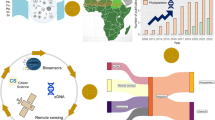Abstract
A benthic index for northern Gulf of Mexico estuaries has been developed and successfully validated by the Environmental Monitoring and Assessment Program for Estuaries (EMAP-E) in the Louisianian Province. The benthic index is a useful and valid indicator of estuarine condition that is intended to provide environmental managers with a simple tool for assessing the ecological condition of benthic macroinvertebrate communities. Associations between the benthic index and indicators of hypoxia, sediment contamination, and sediment toxicity were investigated to determine the most probable cause(s) of degraded benthic condition. The results showed that, on a local scale, the associations between the benthic index and potential environmental causes differed among estuaries. In Pensacola Bay, FL, for example, there was a significant association between the levels of toxic chemicals (e.g. DDT, silver, and TBT) in the sediment and the benthic index, especially in the bayous which have known sediment contamination problems. In Mobile Bay, however, degraded benthic communities were more closely associated with eutrophication and hypoxia. Nevertheless, a benthic index is a valuable tool for identifying areas that could be already degraded and tracking the status of environmental condition in large geographical regions.
Similar content being viewed by others
References
Berger, V. Ya., Naumov, A. D., and Babkov, A. I.: 1995. Russian J. of Mar. Biol. 21, 41–46.
Blaylock, D. A.: 1983, Choctawhatchee Bay: Analysis and interpretation of baseline environmental data, Technical Paper No. 29, Florida Sea Grant College, 237 pages.
Bryan, G. W and Langston, W. J.: 1992, Environ. Poll. 76, 89–131.
Carr, R. S., Chapman, D. C., Howard, C. L., and Biedenbach, J. M.: 1996. Ecotoxicology 5, 341–364.
Collard, S. B.: 1991, Surface water improvement and management (S.W.I.M.) program. The Pensacola Bay System: Biological Trends and Current Status. Water Resources Special Report 91-3, Northwest Florida Water Management District, Havana, Florida.
Di Toro, D. M., Mahony, J. D., Hansen, D. J., Scott, K. J., Hicks, M. B., Mayr, S. M., and Redmond, M. S.: 1990, Environ. Toxicol. Chem. 9, 1487–1502.
Engle, V.D., Summers, J.K., and Gaston, G.R.: 1994, Estuaries 17, 372–384.
Galveston Bay National Estuary Program (GBNEP): 1996, The State of the Bay — a Characterization of the Galveston Bay Ecosystem, GBNEP-44, 232 pages.
Gilbert, R. O.: 1987, Statistical Methods for Environmental Pollution Monitoring, Van Nostrand Reinhold, 320 pages.
Heitmuller, P. T. and Valente, R.: 1991, Environmental Monitoring and Assessment Program: EMAP-Estuaries Louisianian Province: 1991 quality assurance project plan, EPA/ERL-GB No. SR-120, U.S. Environmental Protection Agency — Office of Research and Development (USEPA ORD).
Hosmer, D. W. and Lemeshow, S.: 1989, Applied Logistic Regression, John Wiley & Sons, 307 pages.
Long, E. R., MacDonald, D. D., Smith, S. L., and Calder, F. D.: 1995, Environ. Mgmt. 19, 81–97.
Luoma, S.: 1989, Hydrobiologia 176/177, 379–396.
Macauley, J. M.: 1992, Environmental Monitoring and Assessment Program: Louisianian Province: 1992 Sampling: Field Operations Manual, EPA/ERL-GB No. SR-119, U.S. Environmental Protection Agency-Office of Research and Development (EPA-ORD).
McFarlane, R.W.: 1996, A conceptual ecosystem model for Sabine Lake, In: Proceedings of the Sabine Lake Conference, Sept. 13-14, 1996, Beaumont Texas, TAMU-SG-97-101, National Oceanic Administration, National Sea Grant Office, 66 pages.
May, E.B.: 1973. Limnol. Oceanogr. 18, 353–366.
Pearson, T. H., and Rosenberg, R.: 1978, Oceanogr. Mar. Biol. Ann. Rev. 16, 229–311.
Pesch, C. E., Hansen, D. J., Boothman, W. S., Berry, W. J., and Mahony, J. D.: 1995, Environ. Toxicol. and Chem. 14, 129–141.
Rabalais, N. N.: 1992, An updated summary of status and trends in indicators of nutrient enrichment in the Gulf of Mexico, EPA/800-R-92-004, U.S. Environmental Protection Agency, Office of Water, 421 pages.
Ranasinghe, J.A., Weisberg, S.D., Frithsen, J.B., Dauer, D.M., Schaffner, L.C., and Diza, R.J.: 1994, Chesapeake Bay benthic community restoration goals, Report CBP/TRS 107/94, U.S. Environmental Protection Agency, Chesapeake Bay Program, Annapolis, Maryland.
SAS Institute, Inc.: 1990, SAS/STAT ® User's Guide, 1696 pages.
Seal, T. L., Calder, F. D., Sloane, G. M., Schropp, S. J., and Windom, H. L.: 1994, Florida coastal sediment contaminants atlas. Florida Department of Environmental Protection, 75 pages.
Summers, J. K., Macauley, J. M., and Heitmuller, P. T.: 1991, Environmental Monitoring and Assessment Program, Implementation Plan for Monitoring the Estuarine Waters of the Louisianian Province — 1991 Demonstration, EPA/600/5-91/228, U.S. Environmental Protection Agency-Office of Research and Development (USEPA-ORD).
Summers, J. K., Paul, J. F., and Robertson, A.: 1995, Toxicol. and Environ. Chem. 49, 93–108.
Turner, R. E., Schroeder, W. W., and Wiseman, W. J.: 1987, Estuaries 10, 13–19.
U.S. Environmental Protection Agency — Office of Research and Development (USEPA-ORD): 1993, R-EMAP Regional Environmental Monitoring and Assessment Program, EPA/625/R-93/012, 82 pages.
Author information
Authors and Affiliations
Rights and permissions
About this article
Cite this article
Engle, V.D., Summers, J.K. Determining the Causes of Benthic Condition. Environ Monit Assess 51, 381–397 (1998). https://doi.org/10.1023/A:1005932630259
Issue Date:
DOI: https://doi.org/10.1023/A:1005932630259




